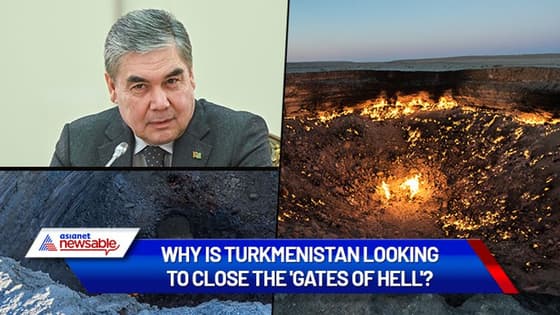
After half a century, Turkmenistan wants to close 'Gates of Hell' blazing crater; here's why
Turkmenistan's President recently called for the country's most notable but infernal sights, 'Gates of Hell', to be extinguished.
Turkmenistan's President recently called for the country's most notable but infernal sights, 'Gates of Hell', to be extinguished. The blazing natural crater located 260 km north of the capital Ashgabat has burned for almost five decades and is a popular tourist attraction to those who visit the country.

Earlier this week, President Gurbanguly Berdymukhamedov instructed officials to find a way to extinguish the flames, citing environmental and economic crises and also highlighting the potentially detrimental impacts the blazing crater can have on those living in its vicinity.
So, what are the 'Gates of Hell' and how did it come into existence?
Located in the Karakum desert, the 'Gates of Hell', officially known as the Darvaza gas crater, is about 60-metres in diameter and 20-metres deep. The blazing cavity was reportedly formed when a Russian drilling operation in 1971 went haywire, forcing a drilling rig to fall into a sinkhole and the Earth to crumble underneath it.
According to reports, the Soviets believed they hit the jackpot in a significant source of oil in the Karakum desert. However, after installing a rigging station with a heavy drill, soon they realised they had miscalculated what lay beneath the desert sand. While drilling, they hit a humungous pocket of natural gas, which sparked the rig to collapse. The geologists set fire to prevent the dangerous fumes from spreading, expecting the gas to burn off in a few weeks. However, the blaze has continued since and also sparked the formation of other craters in the region.
Renamed the 'Shining of Karakum' in 2018, the blazing crater has been called 'man-made' by President Berdymukhamedov, highlighting its adverse effects on both the environment and those living in the region.
"We are losing valuable natural resources for which we could get significant profits and use them for improving the wellbeing of our people," he stated earlier this week.
This is, however, not the first time the Turkmenistan government has attempted to seal the burning crater. In 2004, then-President Saparamurat Niyazov ordered the village of Darwaza located close to the 'Gates of Hell' to disband, not for health and safety reasons, but reportedly because the village was a blemish for those tourists seeking to visit the crater.
In April 2010, President Berdymukhamedov visited the 'Gates of Hell', after which he ordered the crater to be closed. He claimed that the crater was endangering other drilling projects in the vicinity that boasts rich natural resources. However, no action was undertaken to diffuse the flames.
So why is Turkmenistan closing the 'Gates of Hell' now?
With a production of around 75 billion cubic metres every year, statistics suggest that the country has the fourth-largest reserve of natural gases in the world.
A 2010 Reuters report hinted that Turkmenistan hopes to expand its natural gas output in the coming decades to drive sales into Western Europe, India and Pakistan. Currently, Russia, Iran and China source their natural gas from Turkmenistan.
However, predominantly methane, natural gas continues to seep into the 'Gates of Hell', posing a threat to the environment.
Also watch: Why is Kazakhstan on the boil: All you need to know